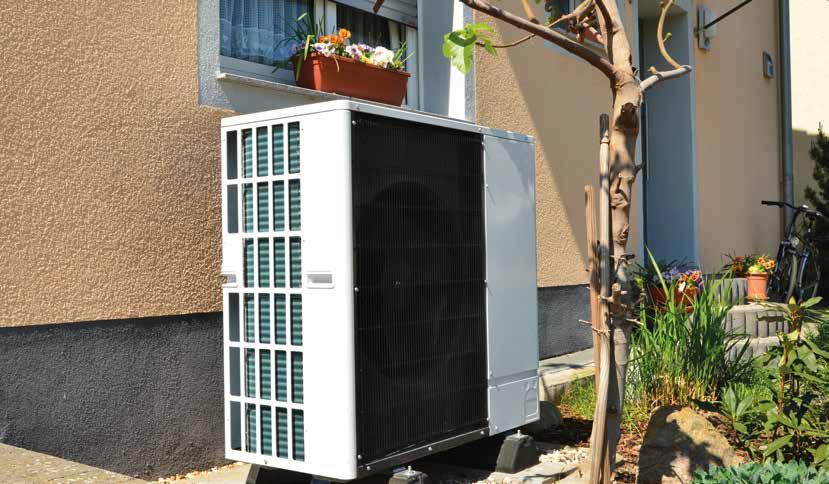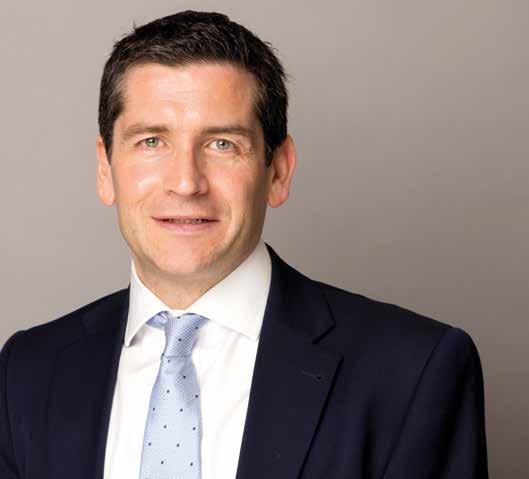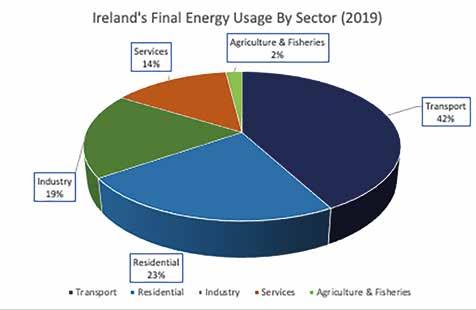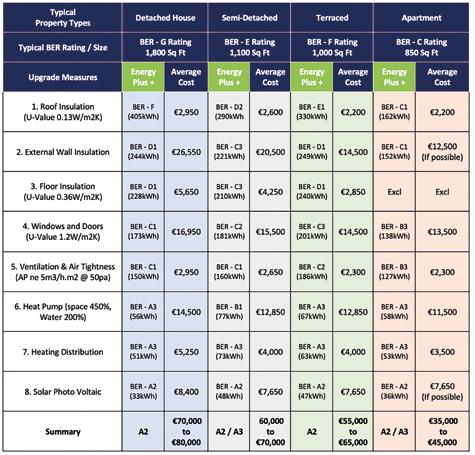
21 minute read
Construction well placed to help government meet its greenhouse gas
Construction well placed to help meet greenhouse gas emissions reduction targets
MICHAEL SLEVIN, Director, KSN, writes about how the government’s plans to reduce Ireland’s greenhouse gas emissions by 51% by 2030 will affect the construction sector and what measures can be taken to reduce emissions and improve the energy efficiency of our existing building stock.
Advertisement

Michael Slevin, Director, KSN. W hen it comes to greenhouse gas (GHG) emissions and the energy usage of Ireland’s built environment, the primary users of energy and contributors to GHG emissions are the residential, commercial and public service sectors. These are significant final energy users, and are therefore a crucial focus for GHG emissions reductions in the government’s Climate Action Plan. Figure 1 shows the GHG emissions by sector in 2020, while Figure 2 shows the final energy usage by sector for 2019. When looking at the energy usage in the built environment, we also need to consider the energy/carbon required to construct
Figure 1. (Source: EPA).

Figure 2. (Source: SEAI). buildings and their associated materials. This is considered later in this article.
IRELAND’S BUILDING RETROFIT PROGRAMME Ireland’s ambitions to improve the energy efficiency and renewable contribution of buildings has been ongoing for over 20 years with step by step iterations of EU targets, Energy Performance of Buildings Directive (EPBD) improvements, building regulations and various other regulations and innovations. However, it is the recent Climate Action Plan 2019 and Climate Action and Low Carbon Development (Amendment) Bill 2021 that demonstrate a firm commitment by the government to achieve tangible results for Ireland.
The new Climate Action Bill provides a framework for Ireland to reduce GHG emissions by 51% by 2030 and become independent in energy production by 2050. It is ironic that 100 years ago, 1921, during the coal strike in England and Wales that calls went out for Ireland to become fuel independent. Now in 2021, there is a real opportunity to achieve this.
The main characteristics of the Climate Action Plan with regard to the built environment include the following key actions by 2030. • 7% per annum reduction in overall
GHG emissions from 2021 to 2030 (a 51% reduction over the decade) and achieving net-zero emissions by 2050. • Retrofitting of existing homes reaching over 500,000 by 2030 to minimum
BER B2 standard, as part of the EU
Renovation Wave strategy. • Homeowners to generate their own electricity and sell it back to the grid under a scheme for micro-generation • 600,000 heat pumps installed (400,000 in existing buildings) • Improve the energy efficiency of public sector buildings by 50% by 2030 – to
BER B ratings • One third of commercial (including
mixed-use) buildings to have a B BER (or carbon equivalent gains) by 2030 • Ensure a suitable policy framework is in place to support district heating.
ENERGY POVERTY A big part of upgrading Ireland’s domestic housing stock provides a huge opportunity to solve the energy poverty crisis. Energy poverty is an inability to light or heat one’s home to an adequate degree, and it currently affects around 17% of Irish households. Within the government’s Climate Action Plan, a strategy to deal with energy poverty is correctly identified and aims to alleviate the burden on the most vulnerable in society through actions focused on improving the efficiency of homes, supporting lowerincome households with their energy costs and minimising the costs associated with action on climate change. In this regard, several government initiatives focus on upgrading these homes and reducing the levels of fuel poverty.
UPGRADING IRELAND’S EXISTING RESIDENTIAL STOCK For this article, I have outlined below common steps available to upgrade an older residential property to achieve a BER rating of A or I have set out indicative costs of carrying out such a retrofit in the Table 1 overleaf. The main principles of upgrading a home have a few basic rules. • Step 1: Fabric first approach – You should always aim to insulate the envelope of a home first through roof, wall and floor insulation, windows and doors. This approach will improve airtightness, benefit the comfort levels in a home and reduce heating requirements. The easiest energy saved in a home is that not used. • Step 2: An air permeability of 5m3/h/ m2@50pa or less is desirable to achieve a high performing home suitable for heat pump installation. Along with this level of airtightness a clear ventilation strategy shall be required and can generally be achieved through a demand control ventilation (DCV), centralised continuous mechanical extract ventilation (CMEV) or mechanical ventilation heat recovery (MVHR) system. • Step 3: The heating centre of a home should be through a heat pump to avoid using fossil fuels and future proof the home for the greening of the national grid in 2030. • Step 4: Install a renewable energy source to provide renewable energy and meet
Part L building regulation requirements.
All works should be designed by a competent designer (technical assessor) and fitted in accordance with current building regulations.

Table 1.

Note: Costs outlined in Table 1 provide a guide on upgrading each property type to A-rating with heat pump installation; VAT is included; excludes any grants or energy credits available; not all upgrade measures are suitable or required to an individual property; each house type should be reviewed by a component designer and specified in accordance with building regulations.
DEALING WITH THE EMBODIED CARBON IN CONSTRUCTING BUILDINGS Energy efficiency in the running of buildings has been well developed over the past 10 years, and most people in the industry understand the ratings and terminology associated with energy certificates such as BER rating, Leadership in Energy and Environmental Design (LEED), etc. The next step for the industry to challenge is to reduce the amount of carbon in building construction and building products, ie, embodied carbon and the life cycle carbon of buildings. This is more important now with our new buildings run efficiently, the larger proportion of carbon is mainly produced in the construction.
IMPORTANCE OF EMBODIED CARBON AS BUILDINGS BECOME MORE EFFICIENT Embodied carbon is beginning to receive more attention from developers, designers, investors, contractors and product manufacturers. The long-term goal is to construct buildings in materials that have required zero carbon to create, install and recycle. To do this, we need to know how to measure and design buildings with new products and methods of construction that enable us to tackle the embodied carbon in buildings. This, in turn, provides a great opportunity for members of the development process to set targets, design and construct in innovative ways and with more sustainable products. Ten years ago, we looked at the operational ratings of our buildings. Now we need to benchmark and rate the construction of our buildings.
ABOUT KSN
KSN is one of Ireland’s leading construction consultancy practices, providing cost management, sustainability management, project management and a number of expert support services to both public and private clients. In 2010, the directors of KSN founded KSN Energy, which focuses on providing bespoke retrofit and sustainability services for the property sector. Over the past 10 years, KSN Energy has developed its team to provide a one-stop-shop that can assist in the retrofitting and upgrading of properties on a significant scale. The services provided include energy auditing and building energy ratings (BERs), project management, quality control, energy credit verification, site conformance inspections, product specification development and other energy-related services.
To date, KSN Energy has managed the upgrade of numerous domestic and commercial properties so that energy usage is reduced to current upgraded retrofit standards, ensuring optimum insulation levels are achieved, renewable technologies are installed, and occupant comfort levels are improved with healthy environments.
Key statistics • 65-member energy team • 65,000 property upgrades managed • 60,000 quality assurance inspections completed • 45,000 BER certificates issued • 7,000 BER audits completed • 1,200 GWh (300 projects) audited.
If you would like to learn more about the work of KSN Energy, visit www.ksn.ie
Michael Slevin is a director of KSN, and manages KSN Energy – A bespoke retrofit and sustainability service for the construction industry – that he jointly founded in 2009.
ACEI sets out its vision to address the climate change challenge
With the publication of the ‘ACEI Sustainability Vision and Commitment to Climate Action’, the Association of Consulting Engineers of Ireland calls for a wholesale change in approach to how our built environment and construction projects are designed and delivered.
The Association of Consulting Engineers of Ireland (ACEI) has set a marker for the built environment sector by placing sustainability at the centre of all that its members do with the publication of the ACEI Sustainability Vision and Commitment to Climate Action.
This document is intended to remind ACEI members and the broader construction industry that the stakes are high, that the status quo cannot continue, and that previous ways of doing things are no longer appropriate.
Speaking about the intent of the sustainability vision, the convenor of the ACEI Sustainability Committee PJ Ryan, Associate Director, Ethos Engineering, explained: “The ACEI Sustainability Vision and Commitment to Climate Action is a reminder that time and effort must be spent in R&D and training to address resilience, long-term sustainability, and societal impacts. We must provide our clients with sustainable solutions that are sufficient for the need, persuading them that alternative innovative solutions will have a significant positive impact for decades into the future. We must also advocate on behalf of our clients with a sustainable vision and ambitions to seek policy, legislation and regulation change that supports sustainable approaches.”
GRAVITY OF THE PROBLEM Marcus Dancey, Director, CS Pringle, and a member of the ACEI Sustainability Committee, was particularly central in developing the Commitment to Climate Action element. He explains that the association is looking to show that it understands and appreciates the gravity of the problem but believes that with the right measures taken early, things can be turned around.
“Our member firms have the opportunity to have a significant impact through our clients and the projects we develop on their behalf,” Dancey explains.
Gemma McCarthy, Dublin City Account Lead, Mott McDonald, and another member of the ACEI Sustainability Committee, adds: “Our role across many and varying projects puts us in a unique position to identify challenges facing clients and to advocate for concerted action within all facets of government and society to deal with these challenges.”
ACEI SUSTAINABILITY VISION The ACEI Sustainability Vision sets out the case for “A future shaped by socially and environmentally responsible design, where true long-term costs and benefits are considered across entire project lifecycles”. The vision states: “The ACEI will continue to help shape policy and to influence consulting engineering firms and their clients to pursue well-conceived projects for the benefit of communities and the environment. Such projects will be planned and designed to go beyond the traditional focus on function, cost minimisation and programme, also to address resilience, long-term sustainability, and societal impacts.”
IMPACTS AND IMPLICATIONS Ultimately, Dancey says that the ACEI believes no project should be embarked upon without a solid knowledge of its likely impact and implications throughout its life and afterwards and those impacts properly costed.
“A project should have no residual costs (financial or otherwise) that are to be borne by people or the environment that have not been properly assessed and these costs properly weighed in the balance of benefits to society, the environment and the economy,” he explains. “Some projects may fail this test and be rightly eliminated from consideration. Repurposing of existing building and infrastructure and building for future repurposing should be very much on the table.”
CHANGE IS COMING In the future, design must expand from simply designing, to deliver a constructed entity that meets regulations to designing for the life of the entity.
Dr Sarah Ingle, Secretary-General, ACEI, says that firms must stop using off-the-shelf solutions that worked previously simply because that is all design fees will allow.
“To continue to use this way of working is to enshrine a suboptimal status quo, and such a status quo – even with a nod to sustainability – is no longer an option. Remuneration for design in construction, and indeed in everything, must cover the proper assessment of the project. Appropriate research will be required to develop sufficient solutions, as opposed to simply generating improvements.”
The ACEI Sustainability Committee that drafted the vision statement comprises PJ Ryan; Marcus Dancey; Gemma McCarthy; David McHugh, Director, RPS; Gareth McElhinney, Technical Director, RPS; Declan Alcock, Executive Director, Varming Consulting Engineers; and Dr Sarah Ingle.

To learn more about the ACEI Sustainability Vision and Commitment to Climate Action, visit www.acei.ie
Laois Hire launches a new interactive website
Laois Hire has launched a new interactive, user-friendly website with many exciting features designed to improve user experience for all customers, whether looking to hire or purchase the latest equipment to meet their specific needs. The quick-click responsive website makes it easy for customers to find the products that they may need from Laois Hire’s vast range.
The company has also installed a “Live Chat Facility”, whereby customers can interact directly in real-time with one of Laois Hire’s experienced sales representatives. If you need advice or help with a product or want to inquire about any of their services or divisions, this is an ideal method of communication.
Another feature coming in the next few months will be an e-commerce element, where customers will be able to buy items from Laois Hire’s product range through the website.
Michael Killeen, Managing Director, Laois Hire Group, said: “We have worked hard to showcase our full range of products, agencies and divisions. We’re very proud of the results. We are going to keep developing the website over the coming year and continue to add value to this important customer platform.”
Laois Hire was established almost 30 years ago. It offers plant and tool hire, and sales services from Irish outlets in Portlaoise, Portarlington, Dublin, Athy, Nurney and Galway.
Laois Hire is committed to developing strong, long-term partnerships with customers. As a service-led organisation, it works with its customers to understand their unique circumstances and develop custom service packages to deliver cost savings, operational efficiencies and performance improvements.
Its customers range from tradespersons and consumers to the most successful and well-known organisations working in the Irish and UK construction, facilities management, energy, infrastructure, retail, community, transport and events sectors.
It has worked on some of the highest-profile projects in Ireland, including the M50, M7 and M8 motorways, N9, Dublin Airport Terminal 2, Monasterevin Bypass and Intel.
It has an integrated logistics division that effectively and efficiently moves stock around the country 24 hours a day.

Check out the new website at www.laoishire.com
Kilsaran has announced the rebranding of its dry products division to KPRO.
The rebrand comes at a time when the company is ramping up production at its plant in Brownstown, Co Kildare, with the addition of a second dry mortar production facility with cutting edge manufacturing technology. The new KPRO brand will feature extensively across the range of dry mortar bag and silo products produced by Kilsaran.
KPRO is the overarching brand that sits across Kilsaran’s seven families of dry mortar products, which include Masonry, Facade, Street, Floor, Crete, Grout And Repair, each with its own distinctive colour. Along with the new branding and packaging, there will be some new additions to the dry mortar product suite.
The second dry mortar plant will significantly increase production capacity with the addition of several new production lines. The plant utilises the most innovative mixing technologies in the dry mortar industry. The commissioning of this new plant will more than double Kilsaran’s dry mortar production capabilities.
Padraic Hogan, Director, Kilsaran, explained: “Rebranding our dry products division to KPRO is an exciting venture for us. The addition of a second dry mortar plant boosts our overall production capacity and demonstrates our commitment to providing quality dry mortar bag and silo products. Our suite of dry products together with technical support and specialist expertise in the industry has driven demand that we are now in a position to fulfil effectively and efficiently.”
A member of the “Guaranteed Irish” family of brands, the Kilsaran Group currently employs more than 500 people at numerous locations around the country. The addition of the new plant in Kildare secures an additional 25 jobs in the new manufacturing facility.
For more information, visit www.kilsaran.ie/ products/kpro-facades-mortars/

Dornan recruiting experienced professionals as it expands pharmaceutical offering
Headquartered in Cork, with operations across the UK and mainland Europe, the Dornan Group is currently seeking experienced professionals to join its ambitious team as it eyes up opportunities in the rapidly growing pharmaceutical sector. With long-standing expertise in this sector, Dornan is placing a renewed focus on its European pharmaceutical operations wing, further strengthening its capabilities to provide innovative solutions to existing and future clients. The company provides integrated end-to-end solutions for mechanical, electrical, instrumentation and fit-out services to the construction industry, including biotechnology, pharmaceutical, semiconductor, data centre, commercial and manufacturing Padraig Finn, clients, plans to fill the positions Operations Director, across multiple locations in Europe. European Pharmaceutical, NEW SENIOR ROLES Dornan Group. The new senior roles will be across a range of specialities, encompassing engineering, construction, and commissioning. To oversee Dornan’s expansion and future growth plans, Padraig Finn has been appointed as operations director of Dornan’s European pharmaceutical wing and charged with leading Dornan’s ambitious European pharmaceutical operations.
An instrumentation and control systems engineer, Finn joins Dornan from Jacobs, where he held the role of vice president of business development in Europe.
Finn says that having been one of the first Irish construction companies to expand into Europe almost 15 years ago, Dornan is now looking again to grow and expand its pharmaceutical client base in Europe. It recently won another large project in Belgium with a global biopharma company, focusing on neurology and immunology.
“We are looking for ambitious and experienced professionals to join our team and play a critical role in this journey,” he says. “We anticipate an over €5bn investment from the sector within Europe over the next five years in pharmaceutical projects including biotech, fill-finish, API, gene and cell therapy, as well as blood fractionation and vaccines. Our team has the unique skillsets to meet these needs, developed over the last 50-plus years working closely with multinationals that have entered the pharmaceutical sector in Ireland, delivering specialist engineering and construction solutions.”
Dornan is recognised internationally as a leading, fully integrated engineering services contractor.

Visit dornan.ie for more information on Dornan’s current opportunities across Europe.
Causeway Donseed customises biometric time and attendance solution for construction-sector
Michael Nugent Ltd, a leading mechanical and electrical services provider in Northern Ireland, has implemented the Causeway Donseed biometric solution across its major construction projects.
The contractor needed a biometric solution that accurately captures the hours worked on site and also stores the workforce’s data in one cloud database while supporting its health and safety commitments.
Before partnering with Causeway, the contractor had tried several electronic time and attendance platforms but found that they were not robust enough for construction sites and didn’t provide data in real-time via the cloud.
In contrast, the Causeway Donseed solution, which has been designed for the construction industry, will enable the contractor to surface data in real-time from a single location, giving the management team the control they need to reduce labour costs, paperwork and project risks.
Michael Nugent Ltd has chosen to use the Causeway Donseed portable all-in-one biometric tablet, which monitors clocking in and out with both fingerprint and facial recognition verification.
Speaking about the implementation, Brendan Gildernew, Contracts Director, Michael Nugent Ltd, said: “We needed to know more than just the hours worked. We wanted to see data in real-time that helped us understand costs better while giving us the agility to make effective decisions. Our sites will be using both fingerprint recognition and facial recognition technology to verify identity at the point of sign in and out.”
The contractor can now access a whole host of labour management data from one centralised location in the cloud. The data will help to ensure compliance by managing time and attendance, tracking training, recording PPE conformance and sending automated email alerts when certifications are expiring.

To learn more about Causeway Donseed’s biometric solution or to book a demonstration, visit www.causeway.com/attend enquiries, orscan the QR code
Samsung Galaxy XCover Pro: A resilient phone that won’t let you down on site
The versatile Samsung Galaxy XCover Pro smartphone has many features that would be useful for working on construction sites, including a rugged outer casing, one-click programable keys and a high performing camera.

The Samsung Galaxy XCover Pro is somewhat different from the general Galaxy range of smartphones. It is specifically designed for working environments and job sites that include construction, healthcare, and retail settings. Of course, it is still intended for the typical smartphone user, particularly those who may be a little harsh with their phone. But the Galaxy XCover Pro is presented by Samsung as having a different set of features and priorities than your typical smartphone.
DURABLE AND INTUITIVE The XCover Pro has been available on the Irish market since 2020. Samsung describes the phone as “a smartphone designed and engineered for frontline workers across a variety of industries”, and it certainly is that.
It has several features that set it apart from many others when it comes to working on site.
RUGGED AND STYLISH It is a rugged yet stylish device. Premium features include an immersive display and protection by the Samsung Knox security platform. One nice touch is that its 4,050mAh battery is easily replaceable for those unable to find a power source but have a backup battery to hand. This might seem a moot point, as there are so many power sources to choose from. But if you do get caught out, it is helpful to have the option of switching the battery.
SIZE AND SCREEN The XCover Pro’s dimensions of 159.9 X 76.7 X 9.94mm (218g) make it sizable but thin. Weighing in at 218g, it is a light device, but not so light that you won’t know it’s there.
It has a clear, large edge-to-edge 6.3” FHD+ Infinity Display with an enhanced touchscreen able to work in any conditions, including rain or snow. YOU CAN LEAVE YOUR GLOVES ON For users in the field, glove mode allows for gloves-on use, and the voice to text message feature provides real-time dictation and messaging for simple, convenient communication.
The device is IP68 water and dust resistant, capable of withstanding multiple drops of up to 1.5 metres, even without a case. It is MILSTD 810G-certified for reliable protection against extreme altitude, humidity, and other severe environmental conditions.
CAMERA The XCover Pro’s 25MP and 8MP dual camera and 13MP front camera take clear photos. Live focus lets you blur the background when you need to make your subject stand out, and you can use the LED torch light to brighten low-light scenes.
KEYS The torch is also operational out of the box by pressing the top key. This is one of two programmable keys that’s function can be changed to create custom one-click actions.
Samsung has removed the physical home button, which has enhanced the elegance and simplicity of the phone design while maintaining its ruggedness.
SECURITY The XCover Pro is built with data security in mind and is protected by Samsung’s defence-grade multi-layered Knox platform. With Samsung Knox, mobile professionals can take advantage of advanced security features like hardware-backed protection, data isolation and encryption and boot- and run-time protection to ensure that businesscritical information is protected against intrusion, malware and other threats. The device also features a fingerprint reader and facial recognition for touch-free accessibility. For full details on all the features of the Samsung Galaxy XCover Pro, visit www.samsung.com/ie/business/
GALAXY XCOVER PRO SPECIFICATIONS
Dimension 159.9 X 76.7 X 9.94mm (218g) Display 6.3” FHD+, Wet Touch, Glove Mode
AP Exynos 9611 (2GHz Octa-core) Memory 4GB + 64GB, microSD up to 512GB Camera Single Front Camera: 13MP, FF, F2.0 Dual Rear 25MP, AF, F1.7 Camera: + 8MP, FF, F2.2 Battery 4,050 mAh, user-replaceable, Fast charging (15W) OS Android 10.0
SIM Dual SIM (EUR), Single SIM (NA) NFC NFC (EMV L1) Augmented Google AR Core Reality Design Full Screen Rugged IP68, 1.5m drop (MIL-STD 810G certified) Sensor Accelerometer, Proximity, Compass, Gyroscope Pogo Pin Charging only Biometric Fingerprint (side) Security mPOS mPOS Ready
irish construction news
irish construction news
M A G A Z I N E D I G I T A L S O C I A L
constructionnews.ie
May 2021
Housebuilders tackle climate change

Tips to prepare for your next PII renewal
1 irish construction news May 2021 Housing focus • Sustainability • Retrofitting • Interviews • Case studies
Keep up to date with all the latest Irish Construction News, features and much more on our website constructionnews.ie
and social media platforms












